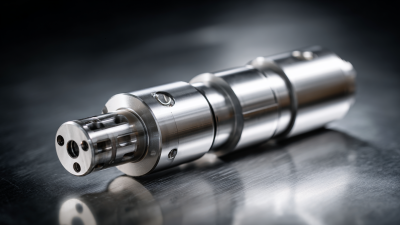The Ultimate Guide to Choosing the Right Stainless Steel Pipe Fittings for Your Projects
In the realm of construction and manufacturing, the choice of materials can greatly impact the overall success and durability of projects. Among these materials, Stainless Steel Pipe Fittings play a crucial role due to their strength, corrosion resistance, and longevity. According to a recent market report by Grand View Research, the global stainless steel pipe fittings market is expected to reach $28.89 billion by 2025, driven by increasing demand from diverse industries such as oil and gas, chemical processing, and water treatment. As such, selecting the right stainless steel pipe fittings is essential for ensuring optimal performance and safety in any application. This ultimate guide aims to provide you with valuable insights and practical tips to make informed decisions when choosing stainless steel pipe fittings for your projects.

Understanding Different Types of Stainless Steel Pipe Fittings and Their Applications
When choosing the right stainless steel pipe fittings for your projects, it is crucial to understand the various types available and their specific applications. Stainless steel fittings are favored in a range of industries due to their corrosion resistance and durability. Common types include elbows, tees, and couplings, each serving distinct functions in piping systems. Recent market analysis shows that the U.S. Mechanical Tube & Pipe Market is poised for significant growth, projected to reach substantial shares across various sectors including construction and manufacturing.
Innovative teaching methodologies, such as using computational fluid dynamics (CFD) simulations, have enhanced understanding of piping dynamics, especially in evaluating the performance of different pipe fittings under turbulent flow conditions. Such approaches not only help predict pressure drops but also inform design choices for improving efficiency in systems that utilize stainless steel fittings. Additionally, the global market for instrument pipe and weld fittings shows promising growth, with increasing demand driven by advancements in material technology and evolving industry standards. As industries continue to innovate, staying informed about the latest trends and technologies in pipe fittings will be essential for optimizing project outcomes.
The Ultimate Guide to Choosing the Right Stainless Steel Pipe Fittings
This chart illustrates the distribution of various types of stainless steel pipe fittings and their common applications in projects. Understanding these applications helps in selecting the right fittings for optimal performance.
Key Factors to Consider When Selecting Stainless Steel Pipe Fittings for Your Project
When selecting stainless steel pipe fittings for your project, several key factors should guide your decision-making process. First and foremost, consider the type of stainless steel used in the fittings, as this directly impacts durability and corrosion resistance. Common grades like 304 and 316 serve different applications, with 316 offering superior resistance to chlorides and saline environments. Assess your project's specific requirements to choose the right grade.
Another crucial factor is the fitting's size and connection type. Ensure compatibility with your existing piping system by noting the nominal pipe size and the threading or welding methods required. Proper sizing prevents leaks and ensures optimal performance.
**Tip:** Always consult manufacturer specifications for detailed dimensions and application guidelines. This can prevent costly mistakes in your project.
Lastly, don't overlook the fitting’s pressure rating. Each fitting comes with a designated maximum pressure it can handle, so be sure to select fittings that can withstand your project's operating conditions.
**Tip:** Testing the fittings in a controlled environment before full installation can help detect any weaknesses or inadequacies early on.

Comparing Seamless vs. Welded Stainless Steel Pipe Fittings: Advantages and Disadvantages
When selecting the right stainless steel pipe fittings for your projects, understanding the differences between seamless and welded fittings is crucial. Seamless fittings are fabricated from a single piece of material, which typically offers better strength and corrosion resistance, making them ideal for high-pressure applications. In contrast, welded fittings are created by welding two pieces together, which can make them more cost-effective and easier to produce in larger sizes and varieties.
A recent industry analysis highlights that the U.S. mechanical tube and pipe market is witnessing significant growth, with welded steel tubes anticipated to capture a substantial share due to their affordability and ease of installation. Additionally, as companies like Venus Pipes & Tubes expand their welded tube capacity by 3,600 MTPA, the demand for these fittings is likely to soar, indicating a robust shift towards welded solutions within various end-use industries.
**Tips:** When choosing between seamless and welded fittings, consider the specific requirements of your project, including pressure ratings and environmental conditions. Additionally, ensure that your supplier adheres to industry standards to guarantee the integrity and safety of the fittings you select. Conduct thorough research on the overall market trends, as they can influence availability and pricing in the near future.
Common Standards and Certifications for Stainless Steel Pipe Fittings Explained
When selecting stainless steel pipe fittings for various industrial projects, understanding common standards and certifications is crucial. The American Society for Testing and Materials (ASTM) provides guidelines that ensure the quality and performance of stainless steel products. For instance, ASTM A312 specifies the requirements for seamless and welded austenitic stainless steel pipes, which are vital in applications requiring excellent corrosion resistance, such as in chemical processing and water treatment.
Moreover, certifications such as ISO 9001 and ASME B16.9 play a significant role in guaranteeing that manufacturers adhere to strict quality management systems and dimensional standards. According to a report by MarketsandMarkets, the stainless steel market is projected to reach USD 145.94 billion by 2027, highlighting the growing demand for reliable and certified pipe fittings. Ensuring that your fittings meet these industry standards not only enhances the safety and durability of your projects but also aligns with regulatory compliance, ultimately leading to better operational efficiencies and reduced long-term costs.
Maintaining and Installing Stainless Steel Pipe Fittings: Best Practices for Longevity
When it comes to maintaining and installing stainless steel pipe fittings, understanding best practices is crucial to ensure their longevity and performance. According to a report by the International Stainless Steel Forum, properly installed and maintained stainless steel components can significantly extend their life cycle, often exceeding 25 years in harsh environments. This is particularly relevant in industries such as oil and gas, where corrosion resistance is paramount. Regular inspections and timely maintenance can prevent issues that may arise from the unique challenges posed by different operating conditions.

To maximize the longevity of stainless steel pipe fittings, it is essential to use the right tools and techniques during installation. The American Society of Mechanical Engineers (ASME) recommends that fittings should not be subjected to excessive torque during installation, as this can compromise their integrity and lead to premature failure. Additionally, using compatible tooling and fasteners can help mitigate risks related to galvanic corrosion, which occurs when dissimilar metals are in contact. Following these best practices can ensure that your stainless steel fittings perform reliably for many years, reducing the frequency of costly replacements and downtime in your projects.
Related Posts
-

Mastering Stainless Steel Pipe Fittings: A Comprehensive Tutorial on Selection and Application
-

Understanding the Challenges with Ppsu Pex Fittings in Modern Plumbing Solutions
-

Ensuring Excellence in Manufacturing Standards for Best Ppsu Pex Fittings
-

How to Select the Best OEM Precision Parts for Your Manufacturing Needs
-

The Future of Quick And Easy Fittings: Revolutionizing Efficiency in Industrial Solutions
-

Ultimate Guide to PVC Pipe Fittings: Understanding Specifications and Industry Trends for Optimal Selection
